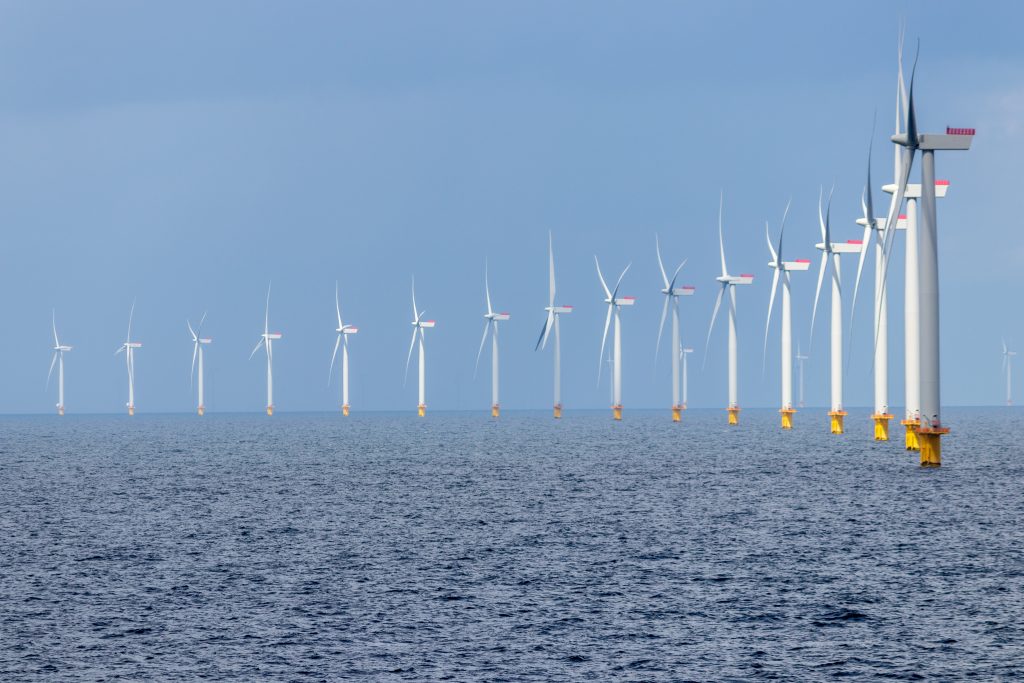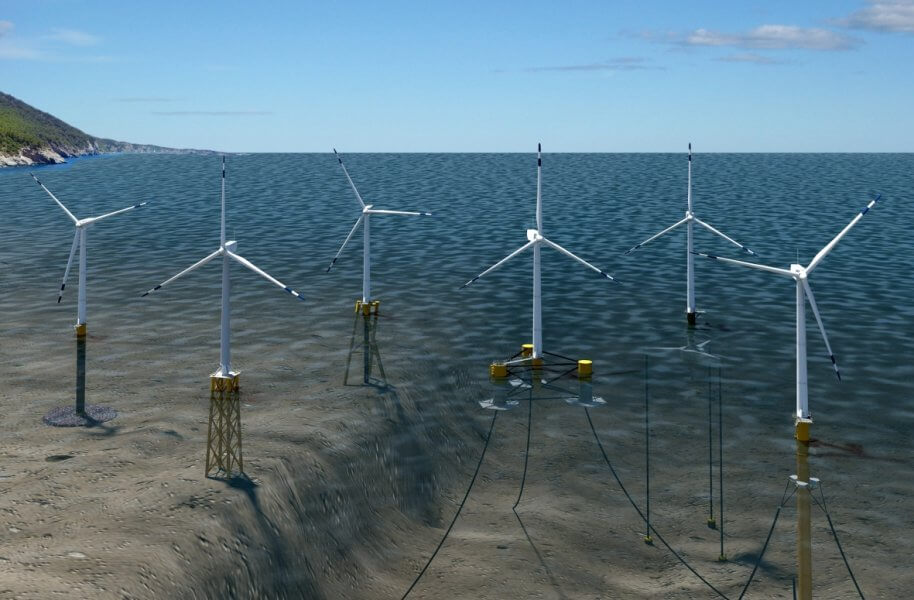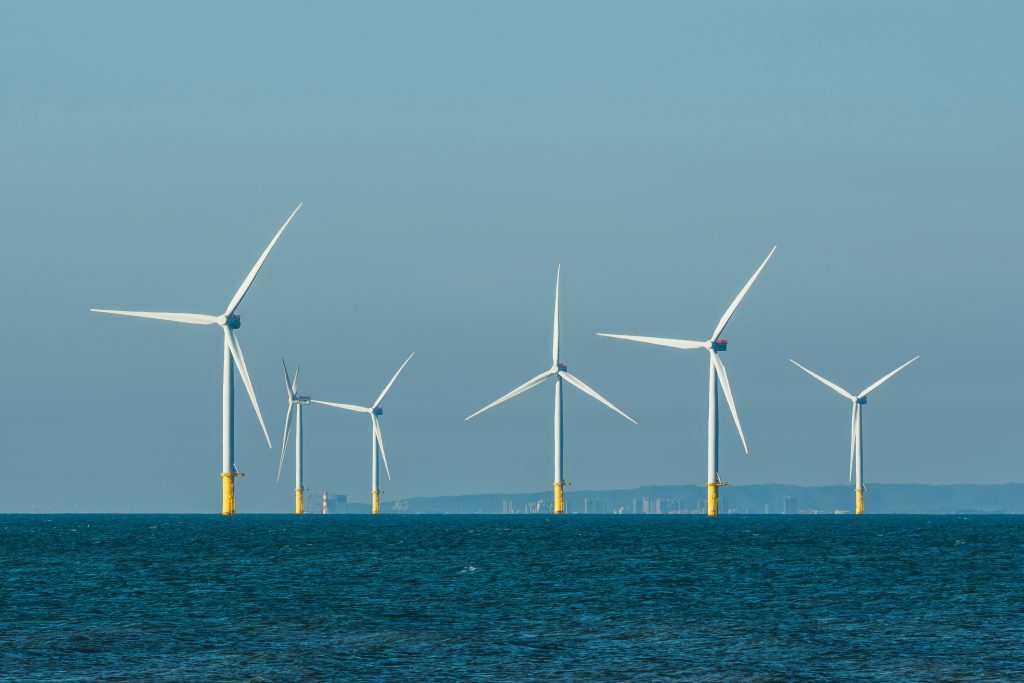Turbine Inspections
Offshore Wind Energy: Powering the World From the Middle of the Ocean
Fast doesn’t always mean better. Well, in the case of wind energy, it kind of does.
That very principle goes to explain why offshore wind power is heralded as the next big thing in renewable energy. The entire concept by which offshore wind farms operate revolves around capitalizing on higher wind speeds over waters with larger turbines.
The result? Wind projects with nearly triple the output of onshore counterparts. To put into perspective, that amounts to roughly a million additional watts over the course of a year.
How Offshore Wind Farms Work

Just because there exists a wide gap in total installed capacity doesn’t mean offshore wind technology comes with some sort of a silver bullet. In fact, the way offshore wind turbines generate electricity is pretty much identical to how it’s done ashore.
Production
Here’s how any given turbine turns wind into electricity:
- Wind blows.
- Rotor blades, along with the drive shaft they’re connected to, spin.
- The gearbox ramps up the resulting rotation to over 100 times.
- The high-speed shaft takes the enhanced energy and passes it on to the generator, where kinetic energy is converted to electricity.
Distribution
Production is only half the story. The rest is getting that electricity delivered to homes and communities.
If anything, though, transmission is a relay, not a sprint. And it may take a little while until the electricity produced from the wind farm reaches your cozy abodes. It needs to make a couple of stops along the way.
- Initial Stop. The electrical energy flows to the offshore substation through the array cables linked to the turbine. There, a step-up transformer jacks up the voltage to prevent energy loss.
- Midway Stop. Through the undersea cables the electricity once again makes its way over to the onshore substation. Capacitor banks installed in the substation recorrect the voltage and the current to fit the grid requirements.
- Destination. Primed for distribution, the electricity is fed to the transmission grid for commercial and residential use.
Types of Offshore Wind Turbines

How long it takes to generate and transmit electricity depends on a few factors. Most obvious among them is distance – the farther off the coast, the longer the process. That much is a no-brainer.
What may not be so obvious is the fact that distance plays a critical role in how offshore turbines stay afloat.
Transitional and Shallow Waters
First things first. Let’s define deep.
Within the context of offshore wind power generation, anywhere above 300 feet is deemed deep. That’s also the extent to which the structural integrity of fixed foundations holds up.
The specific type of foundation depends mainly on depth and seabed conditions. The following is a rundown of four different shapes bottom-fixed turbines take.
- Gravity-Based (~100 ft). A massive piece of concrete or steel ballasted with stones and sediments. Sitting atop a layer of ready-prepared gravel, its sheer weight prevents the turbine from tipping over.
- Monopile (~115 ft). A giant steel nail drilled into a stiff, sandy ocean basin. The undisputed king of fixed foundations that account for 80 percent of all offshore support structures.
- Tripod (82~164 ft). Underneath the monopile-like surface lies a central tower supported by a three-legged frame driven into the seabed. Designed to withstand tidal currents powerful enough to erode the sediments holding the foundation in place.
- Jacket (165~260 ft). Think monkey bars designed for an offshore wind turbine. The lattice-truss structure allows for an even weight distribution, which translates to greater load-bearing capacity and allows for the turbine to stand firm against wave-induced vibrations.
Deep Waters
“Up to 80 percent of offshore wind resources globally are in deep waters where traditional bottom fixed installations are not suitable.” – Irene Rummelhoff, executive vice president at Equinor
As robust as they may be, fixed substructures don’t come cheap. And there comes a point where the cost of manufacturing bottom-fixed installations starts to outweigh the benefits an offshore wind farm can reap.
That’s why deeper waters have been off-limits for so long despite their immense production potential. The money that goes into mass-producing these mammoth pieces of steel hull is simply too much.
Thanks to offshore wind developers who racked their brains for a near decade to come up with a workaround, that’s no longer the case. The entire ocean is now our oyster with the rollout of commercial-scale floating platforms underway.
Now, just like bottom fixed installations, floating foundations can go four ways. Let’s take a closer look.
- Spar-Buoy. Real–life application of Archimedes’ principle in which buoyancy is achieved through displacing a mass of water by partially submerging a vertical cylinder. Kept in position using mooring lines or suction anchors.
- Semi-submersible platforms. Multi-legged cousin of spar foundations. Relies on relatively short-diameter columns and a mooring system for stability.
- Tensioned Legs Platform (TLP). Floater comprised of columns and pontoons. Locked in place with tensioned tendons that prevent vertical motion like heaving.
- Barge. Boat-like platform with a large, flat base. Generally towed to a designated spot with heave plates.
Offshore Wind Generation Benefits

As new technologies continue to scale, offshore wind power capacity is slated to go from 40 gigawatts (GW) to a whopping 630 GW over the next three decades. Even among industries experiencing a double-digit increase, growth at such a breakneck pace is unheard of.
Being an inexhaustible yet explosive source of green energy, the mass appeal of offshore wind may seem almost self-explanatory. But there’s much more to offshore wind than just that.
The following are three major benefits offshore wind has to offer.
Production Capacity
All else equal, a wind speed of 15 mph generates twice as much electricity as 12 mph. As such, a seemingly minor increase in wind speed leads to a dramatic rise in energy production.
That’s to say seabased farms can churn out the same amount of energy onshore wind farms produce with fewer turbines when, ironically, there’s much wider space to install more over the waters.
Job Creation
To what end are governments around the world pumping millions of dollars into large-scale initiatives as that of the Inflation Reduction Act? To incentivize the use of alternative energy other than fossil fuels in an effort to reduce greenhouse gases?
On the surface, perhaps so. But just as vital is the economic incentive, which comes in the form of job creation.
Keep in mind that manufacturing, installing, and maintaining offshore wind turbines are complex maneuvers that draw from a concerted effort by multiple supply chains and verticals. And as offshore wind kicks into higher gear, the demand for jobs across engineering, maritime trade, finance, and other corresponding fields will grow proportionally.
Talking numbers, the offshore wind industry in the U.S. alone is expected to post up to 58,000 additional jobs annually for the next seven years.
Community Revitalization
Robust job growth alone isn’t enough to infuse communities with newfound vitality. But once new facilities are up and running? Now, that’s a different story.
Notably, when these facilities start working with local suppliers and businesses, it’s only a matter of time before the neighborhood becomes a manufacturing hub.
As regards to coastal towns heavily reliant on the tourism economy, the chain of events depicted here is beyond favorable.
Give the following case studies from American Clean Power Association and Orsted a read to get a detailed look into the process by which offshore wind brings new prospects and opportunities across coastal communities.
Environmental Impacts
One doesn’t need to be a wildlife biologist to suppose that dotting the sea floor with gigantic steel girders would carry some sort of implications for marine mammals and their habitat.
While much of its environmental impact is yet to be explored, research suggests that offshore wind’s effect on biodiversity should be considered net positive, not the other way around.
The reasons are threefold.
- Rigorous Preliminary Screening. Offshore installations don’t happen overnight. Detailed studies must be conducted years in advance under the guidance of the Environmental Protection Agency (EPA) to assess the compatibility of the site with maritime uses. Only after dotting all the i’s and crossing all the t’s follows the go sign to move forward.
- Buffer Technologies. From Iberdrola‘s noise mitigation solution to Orsted’s coral restoration project, the industry is seeing the emergence of cutting-edge technologies designed to accommodate the symbiosis between marine life and wind farms.
- Climate Change Mitigation. It’s no secret that rising temperatures impose irreversible damage to marine ecosystems. By mitigating carbon emissions and stabilizing the climate, offshore wind power can expedite the much-needed restoration of marine life.
Making the Most Out of Offshore Wind Projects
If there’s any downside, it’s that offshore wind can turn out to be relatively high maintenance. Particularly since offshore wind turbine components are exposed to high winds and sea waves, the need for consistent, proper care tends to be more pronounced than land-based counterparts.
Though fantastic in their own right, inspection solutions using industrial-grade drones come with all sorts of logistical complications that throw routine maintenance out of the question.
With a plug-and-play solution that delivers quality inspections with commercial off-the-shelf drones, however, it’s a whole ‘nother ballgame. Give NearthWIND Mobile a go and let the magic of spot checkups unlock the potential of your offshore initiatives.
